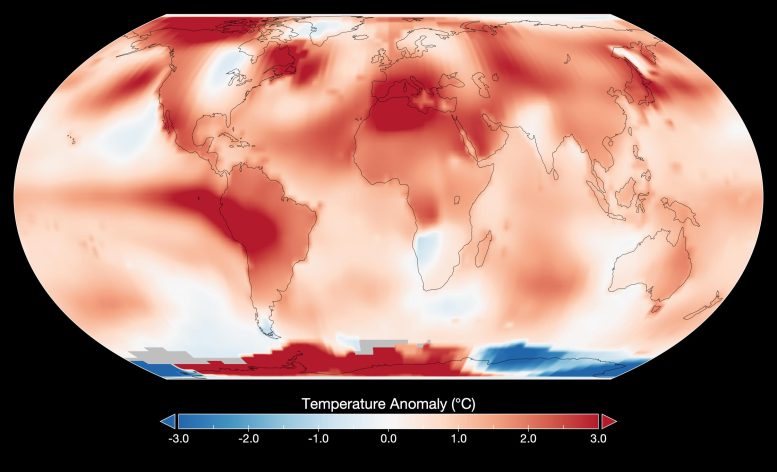
This map shows global temperature anomalies for July 2023 according to the GISTEMP analysis by scientists at NASA’s Goddard Institute for Space Studies. Temperature anomalies reflect how July 2023 compared to the average July temperature from 1951-1980. Credit: NASA’s Goddard Institute for Space Studies
According to NASA’s GISS, July 2023 was the hottest month on record, with significant temperature increases observed globally. The report underscores the human-driven warming trend, primarily due to greenhouse gas emissions, and highlights the urgent need for climate action. The record heat has been influenced by the development of El Niño.
July 2023 was hotter than any other month in the global temperature record according to scientists at NASA’s Goddard Institute for Space Studies (GISS) in New York.
“Since day one, President Biden has treated the climate crisis as the existential threat of our time,” said Ali Zaidi, White House National Climate Advisor. Against the backdrop of record-high temperatures, wildfires, and floods, NASA’s analysis puts into context the urgency of President Biden’s unprecedented climate leadership. From securing the Inflation Reduction Act, the largest climate investment in history, to invoking the Defense Production Act to supercharge domestic clean energy manufacturing, to strengthening climate resilience in communities nationwide, President Biden is delivering on the most ambitious climate agenda in history.”
Record-Breaking Temperatures
Overall, July 2023 was 0.43 degrees Fahrenheit (0.24 degrees Celsius) warmer than any other July in NASA’s record, and it was 2.1 °F (1.18 °C) warmer than the average July between 1951 and 1980. The primary focus of the GISS analysis is long-term temperature changes over many decades and centuries, and a fixed base period yields anomalies that are consistent over time. Temperature “normals” are defined by several decades or more — typically 30 years.
“NASA data confirms what billions around the world literally felt: temperatures in July 2023 made it the hottest month on record. In every corner of the country, Americans are right now experiencing firsthand the effects of the climate crisis, underscoring the urgency of President Biden’s historic climate agenda,” said NASA Administrator Bill Nelson. “The science is clear. We must act now to protect our communities and planet; it’s the only one we have.”
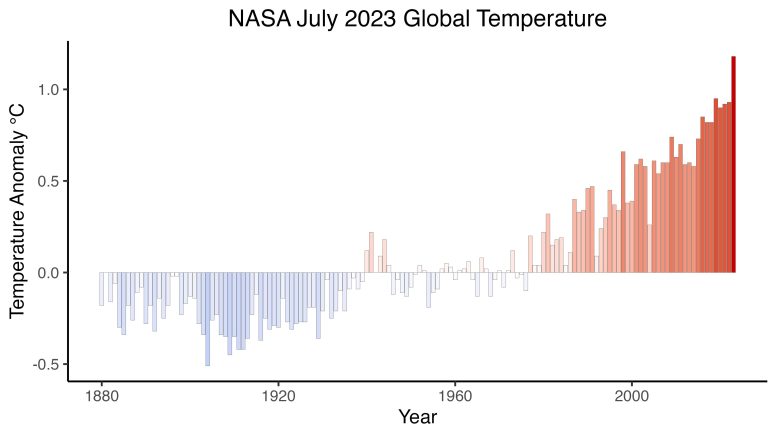
This chart shows global temperature anomalies for every July since the 1880s, based on NASA’s GISTEMP analysis. Anomalies reflect how much the global temperature was above or below the 1951-1980 norm for July. Credit: NASA’s Goddard Institute for Space Studies / NASA’s Earth Observatory
Global Impact
Parts of South America, North Africa, North America, and the Antarctic Peninsula were especially hot, experiencing temperatures increases around 7.2 °F (4 °C) above average. Overall, extreme heat this summer put tens of millions of people under heat warnings and was linked to hundreds of heat-related illnesses and deaths. The record-breaking July continues a long-term trend of human-driven warming driven primarily by greenhouse gas emissions that has become evident over the past four decades. According to NASA data, the five hottest Julys since 1880 have all happened in the past five years.
“Climate change is impacting people and ecosystems around the world, and we expect many of these impacts to escalate with continued warming,” said Katherine Calvin, chief scientist and senior climate advisor at NASA Headquarters in Washington. “Our agency observes climate change, its impacts, and its drivers, like greenhouse gases, and we are committed to providing this information to help people plan for the future.”
Data Collection and Analysis
NASA assembles its temperature record from surface air temperature data from tens of thousands of metrological stations, as well as sea surface temperature data acquired by ship- and buoy-based instruments. This raw data is analyzed using methods that account for the varied spacing of temperature stations around the globe and for urban heating effects that could skew the calculations.
“This July was not just warmer than any previous July – it was the warmest month in our record, which goes back to 1880,” said GISS Director Gavin Schmidt. “The science is clear this isn’t normal. Alarming warming around the world is driven primarily by human-caused greenhouse gas emissions. And that rise in average temperatures is fueling dangerous extreme heat that people are experiencing here at home and worldwide.”
Ocean Temperatures and El Niño
High sea surface temperatures contributed to July’s record warmth. NASA’s analysis shows especially warm ocean temperatures in the eastern tropical Pacific, evidence of the El Niño that began developing in May 2023. Phenomena such as El Niño or La Niña, which warm or cool the tropical Pacific Ocean, can contribute a small amount of year-to-year variability in global temperatures. But these contributions are not typically felt when El Niño starts developing in Northern Hemisphere summer. NASA expects to see the biggest impacts of El Niño in February, March, and April 2024.



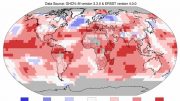
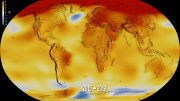
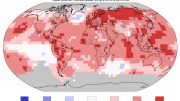
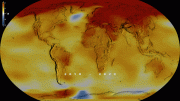


Where are the error bars on that figure? It is the duty of the scientist to report the uncertainty associated with measurements like these.
One rarely sees them in climatological reports, even in academic publications.
“Temperature “normals” are defined by several decades or more — typically 30 years.”
Then why bother to explain anomalies for a single month. That is weather, not climate. Furthermore, the anomaly map is misleading. An extra 3 or 4 degrees C in the northern hemisphere Summer can be more than uncomfortable; it can be life threatening, particularly if the humidity is high. However, 3 or 4 degrees C warmer in the middle of the Antarctic Winter is really inconsequential. This is a case of trying to make a mountain out of a mole hill! This is poor science and NASA should be embarrassed at being compelled to write such material to support President Biden’s agenda.
Strange, 1880 is the time period when scientists agree the last ice age ended. I’m not a climate “expert”, but I’ve always thought the very definition of the end of a global ice age was global warming.
Also strange, here in SC it’s been unusually mild all spring and summer, we haven’t hit 100 once yet. Matter of fact the “hottest temps on record” have just occurred in relatively small pockets. For global warming it doesn’t seem to be very global.